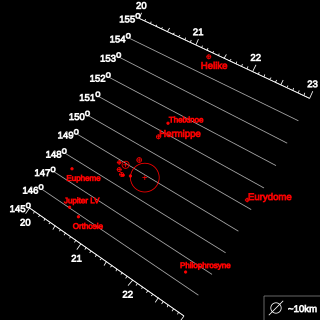Carme group
group of satellites orbiting Jupiter From Wikipedia, the free encyclopedia
Remove ads
The Carme group is a group of retrograde non-spherical moons of Jupiter that follow similar orbits to Carme and are thought to have a common origin.
Their semi-major axes (distances from Jupiter) range between 22,900,000 and 24,100,000 km, their inclinations between 164.9° and 165.5°, and their orbital eccentricities between 0.23 and 0.27 (with one exception).

The core members include (from biggest to smallest):[1][2]
- Carme (the biggest, which gives its name to the group)
- Taygete
- Eukelade[3]
- S/2003 J 5[3]
- Chaldene
- Isonoe
- Kalyke (redder than the others)
- Erinome
- Aitne
- Kale
- Pasithee
- S/2003 J 9[3]
- S/2003 J 10[3]
The International Astronomical Union (IAU) reserves names in -e for all retrograde moons, including this group's members.

Remove ads
Origin
The Carme group may once have been a single body that was broken apart by an impact. Further support to the single body origin comes from the known colours: all the moons appear light red,[4] and infrared spectra, similar to D-type asteroids.[5]


Remove ads
References
Wikiwand - on
Seamless Wikipedia browsing. On steroids.
Remove ads
